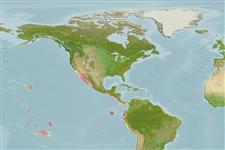Elasmobranchii (haaien en roggen) (sharks and rays) >
Myliobatiformes (Stingrays) >
Dasyatidae (Stingrays) > Dasyatinae
Etymology: Dasyatis: Greek, dasys = rough, dense (Ref. 45335).
More on author: Garman.
Issue
This species is synonym of Dasyatis dipterura Jordan & Gilbert, 1880. See nomenclatural details in Eschmeyer (CofF ver. Oct. 2012: Ref. 92135). The species page will be removed.
Environment: milieu / climate zone / depth range / distribution range
Ecologie
marien demersaal; diepte 1 - 70 m (Ref. 37955), usually 1 - 17 m (Ref. 9254). Subtropical; 42°N - 19°S, 161°W - 70°W
Eastern Pacific: Hawaii and from California, USA to Peru.
Grootte / Gewicht / Leeftijd
Maturity: Lm ? range ? - ? cm
Max length : 187 cm TL mannelijk / geslacht onbekend; (Ref. 40637); common length : 120 cm TL mannelijk / geslacht onbekend; (Ref. 9254); max. gepubliceerd gewicht: 46.3 kg (Ref. 40637)
Found in bays, in sea grass beds, kelp beds, and near reefs on sand and mud bottoms (Ref. 12951). Digs in the sand to feed (Ref. 5227). Feeds on small fishes, crabs, clams, and other benthic invertebrates (Ref. 37955). Ovoviviparous (Ref. 50449). Venomous spine on tail.
Levenscyclus en paargedrag
Maturiteit | Voortplanting | Paaien | Eieren | Fecunditeit | Larven
Exhibit ovoviparity (aplacental viviparity), with embryos feeding initially on yolk, then receiving additional nourishment from the mother by indirect absorption of uterine fluid enriched with mucus, fat or protein through specialised structures (Ref. 50449). Distinct pairing with embrace (Ref. 205).
Nishida, K. and K. Nakaya, 1990. Taxonomy of the genus Dasyatis (Elasmobranchia, Dasyatidae) from the North Pacific. In: Pratt Jr., H. L., S. H. Gruber and T. Taniuchi (eds.): Elasmobranchs as living resources: advances in the biology, ecology, systematics, and the status of the fisheries. NOAA (National Oceanic and Atmospheric Administration) Tech. Rept. NMFS 90:327-346. (Ref. 7445)
Status op de Rode Lijst van het IUCN (Ref. 130435)
Gevaar voor de mens
Venomous
Gebruik door de mens
Visserij: van minder commercieel belang; Aquarium: Publieke aquaria
Meer informatie
ReferentiesAquacultuurAquacultuurprofielKweeklijnenGeneticaElectrophoresesErfelijkheidZiektesVerwerkingNutrientsMassaconversie
Tools
Speciale rapporten
Download XML
Internetbronnen
Estimates based on models
Preferred temperature (Ref.
123201): 19.1 - 28.9, mean 24.2 °C (based on 317 cells).
Fylogenetische diversiteitsindex (Ref.
82804): PD
50 = 0.5002 [Uniqueness, from 0.5 = low to 2.0 = high].
Bayesian length-weight: a=0.00646 (0.00265 - 0.01571), b=3.06 (2.86 - 3.26), in cm total length, based on LWR estimates for this (Sub)family-body shape (Ref.
93245).
Trofisch niveau (Ref.
69278): 3.8 ±0.60 se; based on food items.
Weerstandsvermogen (Ref.
120179): laag, minimale populatieverdubbelingstijd 4,5-14 jaar (Assuming fecundity<100).
Fishing Vulnerability (Ref.
59153): Very high vulnerability (90 of 100).
Nutrients (Ref.
124155): Calcium = 8.57 [1.15, 169.73] mg/100g; Iron = 0.64 [0.06, 7.72] mg/100g; Protein = 21.3 [18.9, 23.9] %; Omega3 = 0.179 [0.059, 0.499] g/100g; Selenium = 25.8 [5.2, 131.9] μg/100g; VitaminA = 3.34 [0.29, 35.44] μg/100g; Zinc = 0.41 [0.03, 5.00] mg/100g (wet weight);
